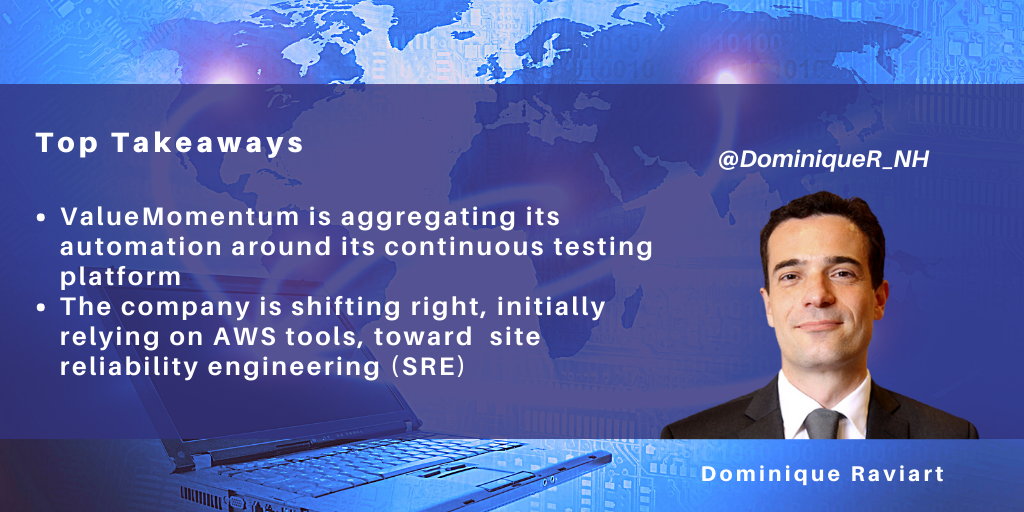posted on Nov 24, 2022 by Dominique Raviart

We recently talked to ValueMomentum about its QE approach to product-centric development and testing. The company is helping its insurance clients improve the quality of their applications using agile best practices and DevOps tools. In support of this, ValueMomentum has refreshed its automation approach and created a continuous testing platform articulated around design (shift-left), execution (through automation), and monitoring (shift-right).
Most tier-one QA vendors today have their own continuous testing platforms, and these have become the backbone of test automation. Indeed, such platforms currently aggregate most of the existing automation and IP, running automation as part of each release cycle. These continuous testing platforms differentiate by adding new automation features to core automation.
Making Continuous Testing the Aggregation for Test Automation
ValueMomentum is investing in continuous testing through methodologies and adding new automation features. The company uses BDD, for instance, as it believes the Gerkhin language remains the best alternative for business users to write test cases that are automatically converted into test scripts, thereby reducing ambiguity in requirements. The company complements its BDD centricity with pre-defined business process diagrams for the insurance industry using MBT (Mantiz).
During the shift-left phase, to promote quality in the development phase of the project lifecycle, ValueMomentum has integrated code-related services into its continuous testing platform (e.g., unit testing and code review); test support services (e.g., test data management and service virtualization; AI-based analytics (such as code coverage and test impact analysis, and static code analysis); and non-functional (e.g., testing, and automated vulnerability assessment). As an example of its investment in AI, ValueMomentum is fine-tuning its defect prediction AI model by increasing data sources, from past defects to code changes in the release and developers’ coding quality.
In the testing environments, once the application release is completed, ValueMomentum uses a mix of full functional test automation (E2E testing) complemented by exploratory testing to maximize the chances of catching bugs before production.
Shift-Right Is the New Frontier. AI Will Help
Shift-right continues to be one of the open frontiers in the QE industry. Feeding back production information to the dev and test teams in an automated manner is still a challenge. AI is increasingly being deployed, but there remains considerable growth potential for its use.
ValueMomentum is accordingly investing in shift-right. Beyond APM tools for application monitoring, the company uses AWS tools for cloud applications, e.g., Canaries (monitoring of the performance of end-user devices), A/B testing (usability research), Game Day (simulating a failure or an event to test applications, processes, and team responses, similar to chaos testing), and rollbacks (redeploy a previous application release using CodeDeploy).
And indeed, ValueMomentum is gradually making its way to Site Reliability Engineering (SRE), where production specialists monitor applications and work with developers to remediate application issues quickly. For now, ValueMomentum is taking an AWS approach, relying on point solutions tools that AWS provides. It is fine-tuning AI use cases such as test case recommendations, defect triaging, defect-to-test case mapping, test case optimization, system comparison, and test case search. This is just the beginning of AI in shift-right for QE.
